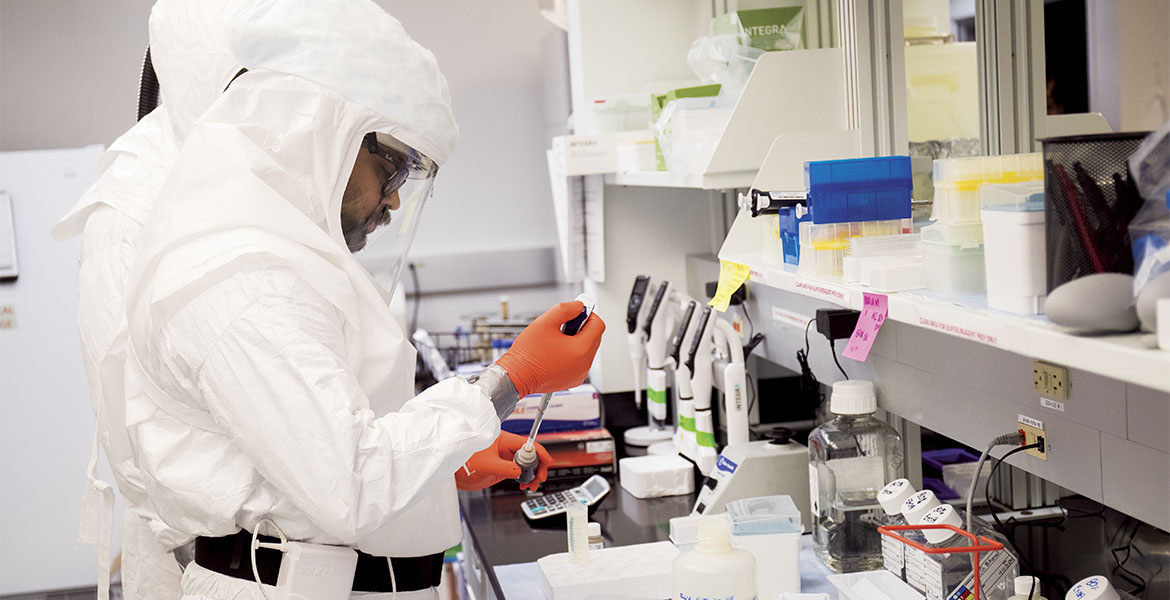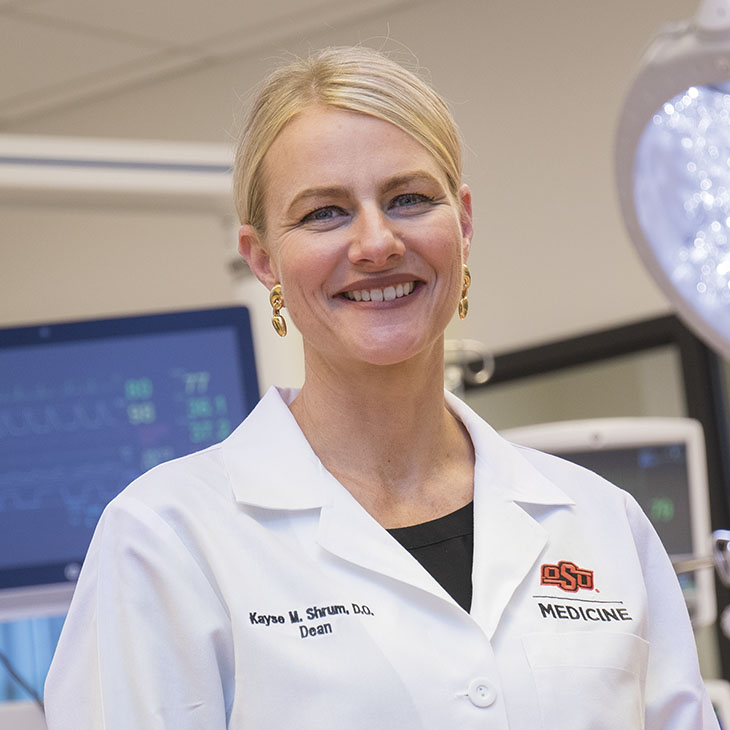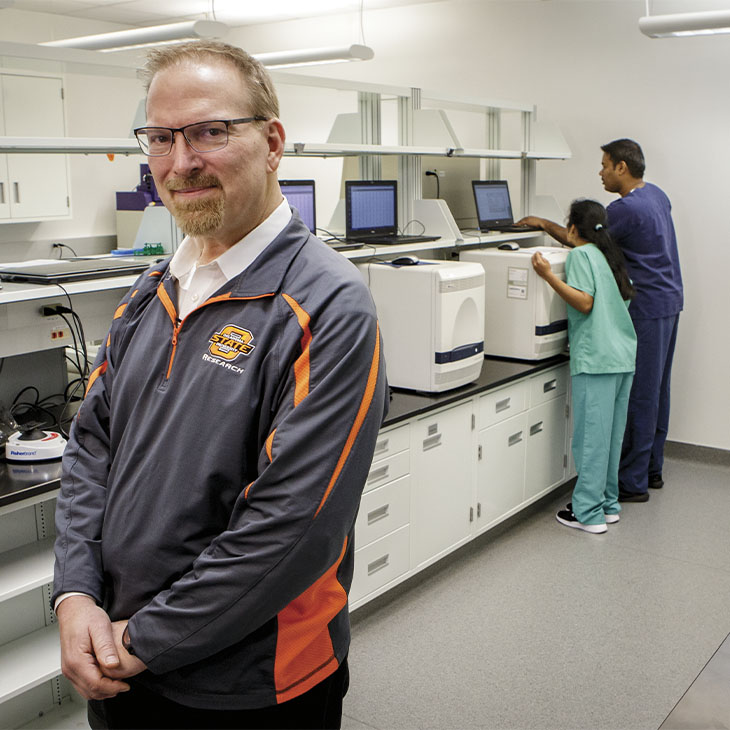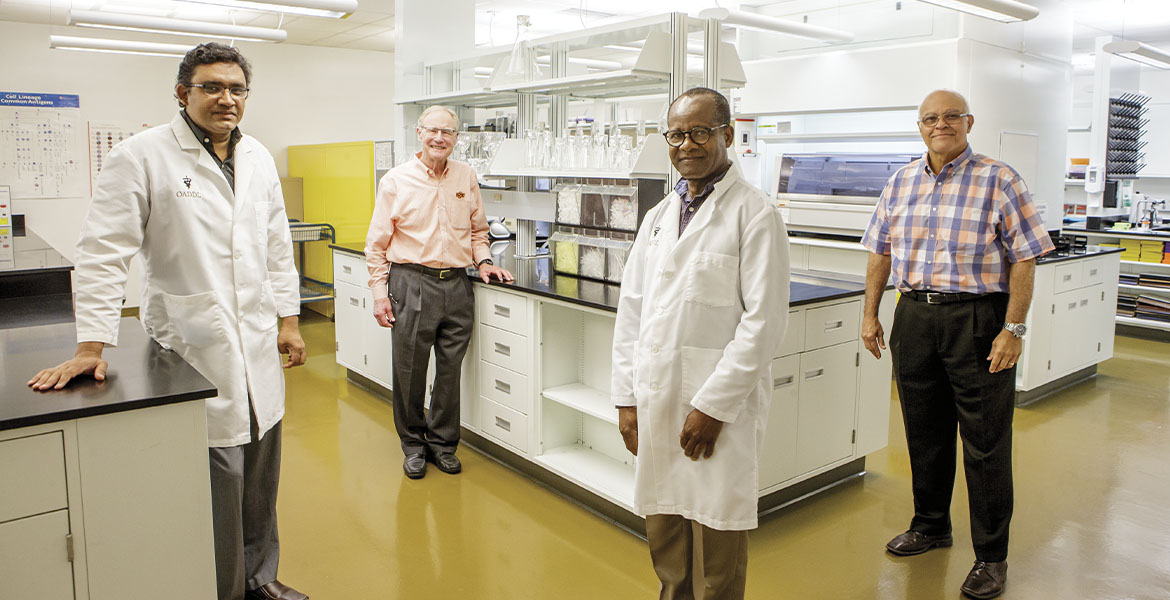
As the pandemic spreads, Oklahoma State battles the virus with an array of responses
Tuesday, September 1, 2020
At the dawn of the new year, the world watched a novel coronavirus gain a foothold in Wuhan, China, before webbing its way around the globe.
COVID-19’s rapid advance was measured in days and weeks, not months and years. On New Year’s Eve, the World Health Organization reported a mysterious pneumonia was sickening dozens of people in China. Three weeks later, the virus was first observed in the United States. And on March 7, COVID-19 arrived in Oklahoma. Two weeks later, there were 53 confirmed cases. By the end of March, that number would swell to 565 and continue to grow exponentially.
On the forefront of Oklahoma’s response was Oklahoma State University, leading from the governor’s office and offering an increased testing capacity to diagnose patients, protect health care workers and create an accurate picture of the spread of the virus.

Dr. Kayse Shrum, president of the OSU Center for Health Sciences and the dean of the College of Osteopathic Medicine, was already involved as a leader with the state government before the arrival of the virus. In March 2019, Gov. Kevin Stitt appointed her to his cabinet as the secretary for science and innovation. On March 13, 2020, he asked her to be part of the COVID-19 Solution Task Force — the only physician on his cabinet.
Every day beginning in mid-March, the group pored over the number of confirmed positive cases and the number of hospital beds occupied. They kept a running inventory of resources statewide, from personal protective equipment to hospital capacity and ventilators.
“It’s a huge undertaking to begin to understand what resources we have available in Oklahoma,” Shrum said. “How do we predict what we are going to need and how do we build a plan? If we were to have a catastrophic event like we watched play out in New York, how would we handle that as a state?”
Late nights, early mornings and many 18-hour days followed. The decision-making had to consider the needs of the state’s most populous areas as well as its most rural.
“We were limited on our testing capability and had to prioritize testing for hospitalized patients and health care workers,” Shrum said. “We were getting a really high number of positives, as well as seeing a very high number of positives in hospitals because we were only testing the very ill.”
In the early stages of COVID-19’s spread, Oklahoma ranked in the bottom five states for testing. The lack of testing created a misleading picture of COVID-19 in Oklahoma and made forecasting future conditions nearly impossible. Without data, making plans was an educated guess at best — or worse, a shot in the dark.
"We are an academic institution but we were able to be nimble and meet the needs of our state and our communities when they needed us the most."
Shrum knew that much more testing was needed and wondered if OSU might be able to help. Little did she know that Dr. Kenneth Sewell, OSU’s vice president for research, was already taking inventory of testing equipment and expertise across the Stillwater campus that might contribute to COVID- 19 diagnostic testing, and had discovered most of the critical ingredients in the Oklahoma Animal Disease Diagnostic Laboratory (OADDL).
“We had faculty literally from all over the campus wondering aloud, emailing each other and including me in the conversation, asking if their laboratory, their equipment or their own expertise could be relevant to the COVID- 19 crisis,” Sewell said. “We quickly discovered the highest concentration of the tools directly applicable to human diagnostic testing was at OADDL.”

Sewell teamed up with Shrum and OSU Medicine’s chief operating officer Dr. Johnny Stephens to add the necessary human medicine expertise to the mix, gain CLIA certification, add more testing equipment and stand up the COVID- 19 diagnostic lab within the OADDL facilities in Stillwater. The perfect storm of conditions and ideas made it possible for Oklahoma State to introduce a human testing lab for COVID-19 in days.
Stephens called the creation of the COVID-19 lab “innovation at its best.”
“It’s the Cowboy way,” he said. “We have a public health crisis on our hands. Lives are at stake. How do we collaborate and bring together the vast resources across the OSU System to get this job done? It’s a leave-the-ego-at-the-door, roll-up-your-sleeves, think-out-of-the-box mentality. That’s unique. That’s the OSU spirit.”
One key to the lab’s success was the solid foundation already in place.
OADDL is one of only 19 Level 1 laboratories in the National Animal Health Laboratory Network. Accredited for all animal species by the American Association of Veterinary Laboratory Diagnostics since 1976, the lab processed more than 18,500 cases in 2019, consisting of about 100,000 tests.
Dr. Jerry Saliki took over as the director for OADDL in the middle of the pandemic. With a degree in veterinary medicine and a doctorate in virology, Saliki returned to OSU on April 30 after serving for 15 years as a lab director at the University of Georgia. He was not surprised to discover OADDL was selected to provide COVID-19 testing for humans.
“Humans are just an additional species to us,” he said. “It’s the same test, the same quality system.”
Human testing certification came with stipulations, though. Clinical Laboratory Improvement Amendments, or CLIA, certification from the Center for Medicare/Medicaid Services (CMS) is required. It normally takes at least four weeks to earn CLIA certification. OSU did it in six days.
OSU Medicine in Tulsa already had a lab CLIA certified for human testing. OADDL had the most machines and the largest staff able to run the tests. In a new partnership between the two campuses, the lab director at OSU Medicine, Dr. Anil Kaul, agreed to serve as the Stillwater lab’s clinical director, which helped secure the rapid certification.
The Stillwater lab already had five Thermo-Fisher PCR diagnostic machines. Three more were ordered to give the lab the capacity to test 1,000 to 2,000 human specimens a day while keeping up with the needs of OADDL’s animal testing lab.
The lab also needed test kits, which were in short supply due to the global pandemic. Stephens believes OADDL’s relationship with Thermo-Fisher, the maker of the machines used to run COVID-19 tests at OSU, played a significant role in securing the materials needed.
“Because we had contacts on the animal health side, our sales folks at Thermo-Fisher were able to fulfill large orders of test kits on an expedited basis,” he said. “We anticipated the high demand for testing and placed an order for 10,000 test kits early on. So from the time we identified OADDL and the partnership on March 20 to six days later, we were able to procure test kits and obtain approval as a CLIA-certified lab.”
Sewell knew entering the fight against COVID-19 would require more people carrying the load than the lab had available. The new human testing would mean new procedures outside the testing itself, such as sample intake and data entry. Staff members would need training in health information privacy. Testing human samples also brought a new level of risk from human diseases.
An incident management team was chosen to handle logistics, planning, training and more for the COVID-19 lab. A team of more than two dozen professionals from around OSU volunteered to take on the extra duties, designing a custom courier service, setting up training for current staff, onboarding and training new staff and volunteers who signed on to help, and creating a plan to transition to a sustainable operation under the joint oversight of OSU Research, OSU College of Veterinary Medicine and OSU Medicine.
To jump-start the work of the incident management team, Sewell sent out a survey to the campus on March 27, asking for volunteers to work in the lab. More than 150 responded in less than two hours. In the end, more than 50 ended up volunteering in various roles to support the lab.
Sewell calls the response remarkable, with many acting as if they were honored to be chosen to contribute.
“To meet the need, we had to bring in researchers from around campus who had laboratory experience, get them trained, screened, do health checks and fit them for personal protective equipment so they could add hands and minds and work alongside the OADDL personnel,” Sewell said. “Through it all, we’ve not intended for anyone to work without pay. But we’ve had people come and work in the lab, and for all they knew it was totally volunteer. That’s how willing they are to help.”
The same day Sewell’s survey went out, the OSU Diagnostic Lab started running validation tests with known samples. By March 29, they knew the tests were returning with 100 percent accuracy.

Twelve days after the decision was made to set up the COVID-19 lab, OSU technicians processed the first 53 clinical specimens and reported the results to health care providers. Three days later, health care providers were submitting more than 1,000 specimens a day. The lab has two shifts running the tests, with many personnel working in the lab 18 hours or more a day. Fully staffed, the lab could add a third shift for around-the-clock testing, analyzing more than 2,000 specimens a day.
Saliki, the OADDL director, is quick to praise the OADDL staff who stepped up as well. Some of the OADDL staff in molecular diagnostics were reassigned to the human testing side. Those remaining have maintained the animal diagnostic services for OADDL.
“They took on the inherent risk of handling human specimens from a newly emerging disease,” he said. “You not only have increased work, but the increased risk. They have served unselfishly.”
The lab is providing answers for sick patients and exhausted health care providers, with results being returned in one to two business days and most within 36 hours of specimen receipt. More importantly, the lab has the potential to lessen the trajectory of the disease in Oklahoma, making a difference that will be difficult to quantify.
“Increased testing gives public health officials a more accurate and realistic picture of COVID-19 in Oklahoma. In the beginning of the pandemic, the state has only had the capacity to deal with the situation on the level of the patient,” Sewell said. “OSU has made it possible to reach the level of mapping the spread of the disease. That’s how you flatten the curve.”
OSU’s diagnostic laboratory for COVID-19 doubled the state’s testing capacity the day it accepted the first specimens from health care providers. Other labs in Oklahoma have come online since then, but OSU continues to test around one-third of the specimens collected statewide. The lab has settled into a sustainable operation, and OSU will continue COVID-19 testing for as long as there is a need.
For Saliki, the COVID-19 lab has implications beyond the pandemic — it’s the marrying of animal and human health testing, known as the concept of “One Health.”
“It’s always been veterinary medicine and human medicine — each one doing their own thing,” Saliki said. “But they all use the same concepts, the same machines, the same test systems. To adequately fight disease, one needs to practice One Health and recognize that humans and animals have a lot in common, and we need to work together.”
Although intimately involved with the success of the lab and other measures taken by OSU to serve the state during the pandemic, leaders find the contributions difficult to adequately describe. They’re overwhelmed by the willingness to serve, from senior faculty members to undergraduate students.
“There are a few other veterinary laboratories helping, but the magnitude of ours and the fact that we were the pioneers makes us the envy of nations,” Saliki said. “When I talk to other lab directors, they want to know how Oklahoma pulled this off.”
For all of them, these accomplishments are a hallmark of a land-grant university, sworn to employ its knowledge and research for the betterment of Oklahomans.
“I think people here view their jobs as something bigger than earning a paycheck. They believe they’re here for the students, the state of Oklahoma and their community,” Sewell said.
"[This lab] showed the impact we are always ready to make for the state. Even past this pandemic, we want to see how we can play a part in readiness for the future."
Shrum agreed.
“I cannot even begin to say how proud I am of OSU,” Shrum said. “I think it really highlights the importance of our academic institutions and how they can serve our state in times of great need, not just for education but for catastrophic events. All of the OSU family should be proud of how we carried out our land grant mission. We are an academic institution but we were able to be nimble and meet the needs of our state and our communities when they needed us the most.”
Read more
Volunteers provide the backbone for Oklahoma State's viral testing
Oklahoma State's medical arm steps up to meet health care needs during the pandemic
Oklahoma State's microbiome research could offer clues against COVID-19 and other diseases
Oklahoma State works to mend a broken supply chain with PPE for Stillwater Medical Center
